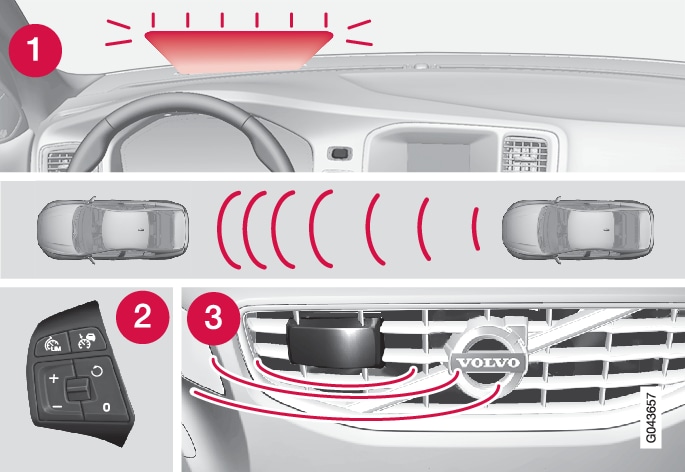Function overview

 Warning lamp - braking by driver required
Warning lamp - braking by driver required Steering wheel keypad
Steering wheel keypad Radar sensor
Radar sensor
Warning
Adaptive cruise control is not a collision avoidance system. The driver must intervene if the system does not detect a vehicle in front.
The adaptive cruise control does not brake for humans or animals, and not for small vehicles such as bicycles and motorcycles. Nor for oncoming, slow or stationary vehicles and objects.
Do not use the adaptive cruise control, for example, in city traffic, in dense traffic, at junctions, on slippery surfaces, with a lot of water or slush on the road, in heavy rain/snow, in poor visibility, on winding roads or on slip roads.
Distance to the vehicle ahead is measured primarily by a radar sensor. Cruise control regulates the speed with acceleration and braking. It is normal for the brakes to emit a low sound when they are being used by the adaptive cruise control.
The adaptive cruise control aims to follow the vehicle ahead in the same lane at a time interval set by the driver. If the radar sensor cannot see any vehicle in front then the car will instead maintain the cruise control's set speed. This also happens if the speed of the vehicle in front exceeds the cruise control's set speed.
The adaptive cruise control aims to control the speed in a smooth way. In situations that demand sudden braking the driver must brake himself/herself. This applies with large differences in speed, or if the vehicle in front brakes heavily. Due to limitations in the radar sensor braking may come unexpectedly or not at all.
The adaptive cruise control can be activated to follow another vehicle at speeds from 30 km/h2 up to 200 km/h. If the speed falls below 30 km/h or if the engine speed becomes too low, the cruise control is set in standby mode at which automatic braking ceases - the driver must then take over himself/herself to maintain a safe distance to the vehicle ahead.
Warning lamp - braking by driver required
Adaptive cruise control has a braking capacity that is equivalent to more than 40% of the car's braking capacity.
If the car needs to be braked more heavily than cruise control capacity and the driver does not brake, then cruise control uses the warning lamp and warning sound from the Collision warning system in order to alert the driver that immediate intervention is required.
Note
Warning
Steep roads and/or heavy load
Bear in mind that the adaptive cruise control is primarily intended for use when driving on level road surfaces. It may have difficulty in keeping the correct distance from the vehicle ahead when driving on steep downhill gradients, with a heavy load or with a trailer - in which case, be extra attentive and ready to slow down.